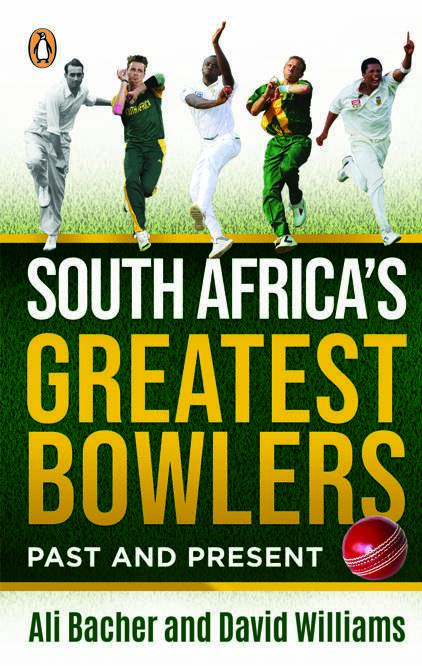
Who are South Africa’s greatest bowlers? Following the success of their books on all-rounders and batsmen, Ali Bacher and David Williams now turn their attention to South Africa’s top bowlers. Muhammad Hussain delves deeper.
South Africa’s Greatest Bowlers: Past and Present by Ali Bacher and David Williams
Penguin Books
198 pages
R260
4/5
Bowlers sometimes tend to get the dirty end of the stick when it comes to cricket.
Maybe it’s because spectators prefer to see swashbuckling sixes, to hear leather being thumped by willow or to see the exquisite sight of a perfectly timed cover drive.
In South Africa, however, we have the utmost respect for bowlers, especially those fast and feisty ones who get into the batter’s face, who make the batter hop, skip and jump, and who wear every emotion on their Protea-emblazoned sleeves.
It’s only fitting then that Ali Bacher and David Williams came together for a third time to finally release their book South Africa’s Greatest Bowlers: Past and Present.
Bacher and Williams feature 18 bowlers from the pre- and post-apartheid eras, condensed into 14 chapters of about 15 pages each, featuring stars of yesteryear such as Hugh Tayfield, Eric Petersen, Allan Donald, Paul Adams and Fanie de Villiers.
The book also features newer bowling heroes such as Dale Steyn, Shaun Pollock, Makhaya Ntini, Vernon Philander and even Kagiso Rabada.
South Africa’s Greatest Bowlers has a nostalgic feel as Bacher describes the bowlers he played with and gives commentary on what made them great.
The pair also makes use of news/feature articles written about these bowlers.
There are some great passages and wordplay, such as that by acclaimed cricket journalist Telford Vice, who is referenced for his description of a speech he heard: “[Barry] Richards was telling the story of a Currie Cup match between Natal and Transvaal, of [Don] Mackay-Coghill letting fly at a young batsman facing him with volleys of vividly vicious verbal venom.”
Or that by the renowned journalist Firdose Moonda: “Scary eyes, throbbing veins and chainsaw celebration have all made Dale Steyn South Africa’s most feared fast bowler.”
My favourite part was easily the chapter written by cricket historian Krish Reddy, who told the story of Petersen and Owen Williams – two black bowlers who could not represent their nation on a global stage owing to not being white.
Petersen is described as a cricketer who, “opening the bowling at a very lively fast-medium pace, caused much consternation among the leading batsmen in the country”, while Williams was regarded as “arguably one of the best left-arm spinners produced in black cricket in this country”.
Their stories of continued struggle for the right to play a game they loved and the treatment of their talents by those who felt they were not human enough were gripping, inspiring and sometimes jaw-dropping.
We don’t like to talk too much about white cricketers who didn’t get the chance to play international cricket owing to the apartheid-era sports boycott, sometimes rightly so, but one cannot overlook the talent that was and could have been on display with the likes of Vincent van der Bijl and Mackay-Coghill.
Both were lucky and privileged enough to carve out some sort of domestic or English careers that earned them reputation and prestige, unlike their black counterparts.
Nevertheless, it was a joy to read of bowlers who used their talents effectively to make batsmen waddle like ducks.
I was concerned that Bacher and Williams had left out a major bowler in South Africa’s recent history – spinner Imran Tahir.
However, he was omitted and disappointingly not mentioned a single time in the book because he had, by all accounts, a terrible test career and didn’t meet the criteria set by the two authors.
“Tahir was very effective at times in ODI [one-day international] cricket, but he played only 20 tests, took fewer than three wickets per test and had a high average of 40.24 per test.
“He also holds the record as the most expensive return without a wicket in test history – zero for 260,” was Williams’ reason for leaving out the Pakistan-born Protea.
Reading about Steyn, Ntini, Pollock and Philander brought back some of my most vivid cricket memories and continually brought a smile to my face as their career highlights were described briefly and without exaggeration.
Some of the more controversial issues of the 18 bowlers were touched but not elaborated on, with the focus remaining firmly on the field of play.
As the cricket season in South Africa starts to wind down, with ODIs and T20s taking centre stage, South Africa’s Greatest Bowlers is a great book with which to walk down memory lane in those pesky middle overs.
It is also easy enough to dip into any chapter without feeling like you’ve missed something.
Bacher and Williams’ third book in a series that celebrates South Africa’s great cricketers is a fun read with good anecdotes that briefly profile the talent possessed by our phenomenal bowlers.




 Publications
Publications
 Partners
Partners










